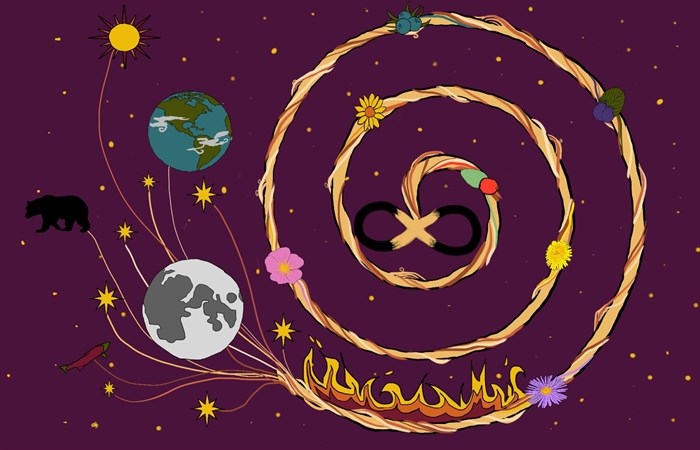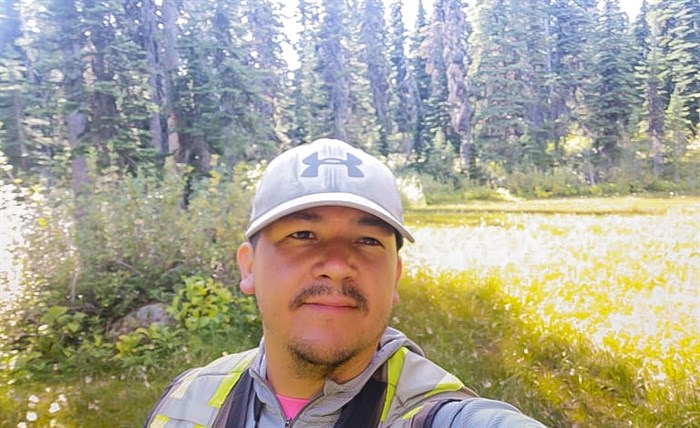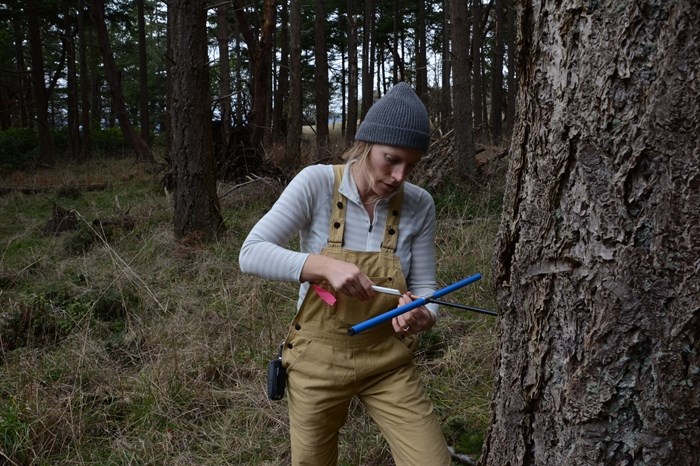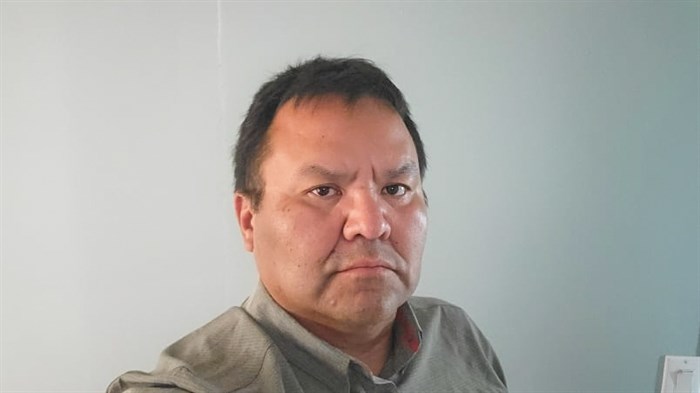
In syilx teachings, the spiral represents all of life, holding teachings, stories, medicines, plants, animals and human life. Fire cleanses creation so it can feed all spirits.
Image Credit: Digital Art by Lauren Marchand
September 01, 2021 - 6:00 PM
Traditional burns offer a way to protect the land, sustain Indigenous cultural practices and unite two very different worldviews, say fire experts.
“Fire is not bad, fire is a life bringer, and the syilx people have lived in harmony with the land in a reciprocal relationship since time immemorial,” says sxuxiya, the Penticton Indian Band’s project manager for the Natural Resource Department.
sxuxiya manages traditional burns in and around snpink’tn (Penticton), in the southern Interior of B.C. on unceded syilx territory.
“Fire is a tool our people have used for thousands and thousands of years to manage our timxw [life force], our lands, our animals, our berries,” says sxuxiya.
“If you plan, as our people have done — where to burn, when to burn and what to burn — fire actually replenishes the land, replenishes our food source, to keep the land healthy.”
In recent months, wildfires have been moving rapidly through the territory. And Kira Hoffman says she sees these fires as a “wake-up call” to settlers to listen to, learn from and work with Indigenous fire management practices.
READ MORE: Prescribed burns aren't just for fire protection, Penticton Indian Band councillor says
She’s a post-doctoral researcher with the University of British Columbia’s Faculty of Forestry.
“One of the things I find really frustrating right now is many agencies saying they don’t have the expertise to engage in more controlled fire on the landscape at the scale we need.
“I think that the big issue is that they are not considering the relevant experience and knowledge of Indigenous Peoples, and the lifelong practice of understanding fire, and being taught fire, and how many ways you can use fire,” she says.
“There are so many examples where people are successfully living with fire in fire-dependent landscapes, because they are a fire-dependent culture and without it, it can totally erode a landscape.”
sx?ux?iya? says he knows “firsthand what we can do when we come together and work together.”
“Whenever we get referrals for prescripted fuel reduction burns or prescribed burns we inform B.C. Wildfire Services [BCWS] that this is syilx territory and we manage our land with fire and we have a very developed process for burn prescriptions, fuel reductions, and fuel modifications and treatment,” he says.
“We [then] lead the project collaboratively because that’s our resources, that’s our timxw.”
Traditional burnings are part of sqilxw life
syilx Peoples have long been practicing traditional burning protocols following syilx scientific methodologies.
Burns were systematic and strategic, he explains.

‘If you plan, as our people have done — where to burn, when to burn and what to burn — fire actually replenishes the land.’
Image Credit: SUBMITTED
“We didn’t just start a fire and let it burn. It was selectively burned, based on multiple values [such as] … berry production … animal population … disease, grasslands, diseased trees.
“And it was not burned every single year. It was one area that was burned, [then] another area burned, and you wouldn’t return to the same area until after quite some time. It might be after four years, or after 20 years. It was all dependent on the landscape.”
Protocols around traditional burning are deeply embedded in the captikw, the oral storytelling laws that guide the values and ethics of the syilx people.
“We have names for everything when it comes to doing burns,” says sxuxiya.
And while the practice is still very active in the snpink’tn area of the syilx territory, colonial governments have made it difficult to carry out, he says.
“The Canadian government has been stifling our efforts to manage our land properly — giving people fines for lighting fires, setting up private properties [and] provincial parks, and stopping us from managing our landscapes with fire.
“I believe, and, because of my training of writing fire prescriptions with a syilx lens on it, that the wildfires we are experiencing today are a product of mismanagement of lands by Canada, and by extension, of course, the province of B.C.,” he says.
Western Science scratches the surface of sqilxw knowledge
As a researcher, Hoffman has been studying pyro-diversity, the role of traditional burns in sustaining the land prior to colonization, and the kind of impacts these burns could have on the land today.

UBC researcher Kira Hoffman says studying in the field alongside Indigenous communities has humbled her.
Image Credit: SUBMITTED/Kira Hoffman
She says her team at UBC has reviewed “a thousand papers” in an effort to better understand “the relationship between biodiversity and controlled burning.”
They’ve found that “it didn’t matter if it was a tundra or a savanna grassland, if you used fire and you used it regularly for cultural purposes, it benefited biodiversity.”
And it’s not just in papers that she’s seen the positive impacts of cultural burns, says Hoffman, who says she worked as a B.C. wildfire fighter for many years prior to becoming a researcher.
“When I’m out on the land, I can see where cultural burnings have happened on the landscape,” she says.
“A south-facing slope, for instance, that has more berries than what should be there. It’s just the highest density of huckleberries, and it’s obvious it’s a cultural burning area … And you can dig down in the soil and see the char, or you can go around and see the fire scars in those meadows.”
This healthy abundance of berry growth is one of the many markers of a healthy thriving ecosystem, she says.
“It’s just really clear that land was managed for so long by people, and people who have unbelievable expertise in fire.”
Hoffman points out that there is a significant difference between what colonial institutions often describe as “prescribed burns” and traditional or cultural burns practiced by Indigenous Peoples.
“The difference between prescribed burning and cultural burning is a very specific community practice. So who does the burning, where the burning is done, and how it’s done is very different,” she says.
What’s interesting is the way these two systems of knowledge are speaking to each other right now, she says.
“The traditional knowledge and [contemporary] fire knowledge … Coming out of Indigenous communities is the same as what the [Western] scientists are saying, too — which is we need more fire on the land. Whether that’s prescribed fire or cultural burning, or best case scenario both.”
“I would really like to see Indigenous-led fire programs,” she adds. “[sqilxw] know how a fire is going to burn. They know when the rains are going to come based on what’s going on. So I’m always totally gobsmacked when I hear there isn’t enough fire knowledge [by governing agencies] to do controlled burning.”
sxuxiya agrees.
“We have thousands of years of knowledge and experience with it, and our resources and knowledge are being seriously underutilized and underfunded,” he says.
Burning with intention
Tim Lezard is a council member for the Penticton Indian Band, based in Snpink’tn. He says in his community, traditional burning is crucial.
“Like any tradition, it is birthed out of necessity,” he says, adding that syilx Peoples knew that the health of the land meant the health of the people.

Tim Lezard has been a councillor with the Penticton Indian Band since 2020. His portfolio includes lands, natural resources and the environment.
Image Credit: SUBMITTED/Tim Lezard
Lezard’s grandmother, Annie Kruger (nee George), was a firekeeper in their family, meaning she held the knowledge around when, where and how to start traditional burns.
“She talked a lot about the berry bushes, like the black caps. She would go burn those, and raspberries, and burn those patches,” he says.
“My dad and uncles would go along the creekside to burn, [and] my grandpa would make them clean up around the creeks and burn up any dead plants,” he says.
“My grandma would always stress you must always have an intention when you first start [a] fire, and ask yourself: ‘What is the intention here?’
Lezard says the provincial government could be spending less on fire suppression and more on proactive measures through fuel management — as his family has done for generations.
“A lot of it is based on fear from colonizers. They came here and colonized our people and they saw our resources as money rather than being part of the land. That’s a big part of it is colonizers’ mentality is more around fire suppression.”
The BCWS should be working with and learning from sqilxw Peoples, says Lezard.
“Our intentions are both going in the same direction,” he says. “Whether it’s quantifiable through western science or … Indigenous science, there will be an overlap and an agreement.”
sxuxiya says that it’s possible to have different governing bodies working together to ensure cultural burns are happening in a good way while respecting syilx values and honouring shared intentions.
“They provide resources, we take the lead, but we collaborate,” he says.
“We go out at their resourcing with our knowledge keepers, our burn specialists, and then we write our prescription and what we do is merge them, so that a burn plan can move forward with our [sqilxw] values and our interests at the forefront of the decision making.”
— This story was originally published by The Discourse.
News from © iNFOnews, 2021